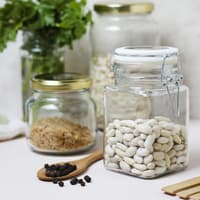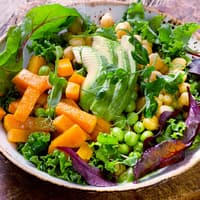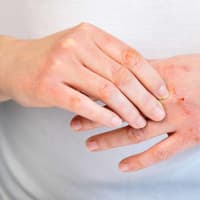
What exactly is sugar?
Conventional household sugar, also known as sucrose, is obtained from sugar beet or sugar cane. It consists of glucose (dextrose) and fructose (fruit sugar). The sugar has a crystalline form and is characterized by its typical sweet taste.
Sugar facts
The German Nutrition Society (DGE), the German Obesity Society (DAG) and the German Diabetes Society (DDG) jointly recommend the following sugar consumption: with a total energy intake of 2,000 kcal/day, a maximum of 50 g of sugar should be consumed. However, sugar consumption is significantly higher than this: around 40 percent for women, around 30 percent for men and even around 75 percent for children.
So it's no wonder that Germans are too fat - with some young people already suffering from severe obesity, the next generation of overweight adults is unfortunately inevitable. This not only has consequences for the individuals concerned: Our healthcare system is also facing ever greater financial challenges due to the consequential damage caused by obesity. The fatal thing is that many people only think of the obvious products such as sweets when they think of sugar. However, sugar is a cheap filler and flavor carrier and is added to many products by the industry - including savory products such as sausage or pizza. No sugar in natural yogurt? There is in some products! If you want to limit your sugar consumption, you need to take a close look at your eating habits as a whole and focus on freshly prepared food.
How is sugar labeled in food?
The ingredients of a finished product are labeled on the food labels - including sugar. You can find the label in the list of ingredients and in the nutritional information.
Only beet and cane sugar is currently labeled as "sugar" in the list of ingredients. But there are other sweeteners such as glucose syrup, fuctose, barley malt extract, lactose, syrups or honey - these must be labeled separately. It is therefore important that you not only look at pure sugar, but also at other types of sugar. The order is a guide to the amount contained in the product: the higher the ingredients are on the list, the more of them there are. Disguised sugar is actually easy to recognize, because there is a simple basic rule: everything marked with "-ose" at the end of the name is a sugar. This includes: Glucose, fructose, dextrose, maltose or lactose.
The nutritional information provides information on calories and ingredients per 100 g. Sugar is listed as a point under carbohydrates "of which sugar" - all types of sugar are included here, including fructose, lactose or glucose. Ultimately, you then have to convert calories and sugar to the actual portion size. Example: 100 g of muesli contains 500 kcal and 20 g of sugar: a muesli portion of 30 g then has 150 kcal and 6 g of sugar.
So the food industry is totally transparent and everything is fine? Unfortunately not. Manufacturers only have to label advertised ingredients; some information is voluntary. This means that the consumer does not know exactly what is in the product, despite the list of ingredients. So the solution is obvious: cook for yourself and eat fewer ready-made products!
Poison: Why sugar is unhealthy
There are many reasons why sugar is unhealthy:
1. too much sugar makes you fat
This applies not only to white industrial sugar, but to sugar in general. This also includes fructose and sugar substitutes such as honey or syrup.
2. too much sugar is bad for insulin levels
Up and down, up and down: When we eat sugar, our body is like a rollercoaster: insulin levels rise extremely quickly and fall just as fast. This results in food cravings and a high risk of diabetes because the body has to constantly produce a lot of insulin.
3. too much sugar makes you ill
In addition to obesity, the following diseases are caused or suspected to be caused by sugar: tooth decay, diabetes, high blood pressure, heart disease, inflammation, cancer, anxiety, nervousness. Sugar also causes tooth decay.
4. too much sugar is addictive
Sugar is actually said to be addictive - mice that were fed sugar water in an experimental laboratory wanted more and more of it. And everyone can see it for themselves: When you're sweet a lot, you feel like you need more. And the feeling is not deceptive: our reward system is to blame: the happiness hormone dopamine is released when we consume sugar and we are happy. Our body and brain want this state of happiness permanently, which is why we crave more. That's why we find it difficult to give up sugar. Another trap: if you eat a lot of sweets, you lose your taste for sweets - which means you eat sweeter and sweeter. Anyone who has managed to give up chocolate and the like for a long time often finds the extreme sweetness unpleasant later on.
So there are many good reasons to reduce your sugar intake to a minimum: By eating less sugar, you will automatically lose weight in the medium term. On the one hand, this is good for your figure, and on the other hand, with less weight and a healthy diet, type 2 diabetes can also be controlled or even completely eliminated. Even common diseases caused by sugar, such as high blood pressure and physical and mental addiction symptoms, can be eliminated by limiting consumption. You will see: If you give up chocolate bars and the like for just two weeks, only eat two portions of fruit a day (1 portion = 1 handful) and use substitute products such as honey or maple syrup sparingly, sugar cravings will be significantly reduced and sticking to it will be child's play. You only have to break the barrier once!
For the reasons mentioned above, sugar is now classified as a poison. Of course, it's the dose that makes the poison - so if you don't exceed the recommended daily amount, you don't need to worry. In addition to products such as sweets, which obviously contain a lot of sugar, the many hidden sugars in ready-made foods are problematic. This makes it difficult for consumers to correctly estimate their daily intake, especially as sugar is not suspected in many foods, such as pizza and sausages. For a healthy diet, you should therefore take a closer look at the foods you like to eat frequently.
How can I tell if I am addicted to sugar?
Among other things, you will experience constant cravings. These attacks are the result of the constantly fluctuating blood sugar levels associated with sugar consumption. Sugar addicts also find it difficult to control themselves once they have had a little sweet treat. Instead of just grabbing a bar of chocolate, they eat the whole bar. Sleep problems and tiredness can also be signs of a sugar addiction. So can secret snacking or constantly wanting to reward yourself with something sweet. Nervousness and irritability when there is nothing sweet within reach can also be warning signs.
Too much sugar: warning signs from the body
If you consume too much sugar, you must be aware that this can also have physical consequences. Because the bacteria in the body feel particularly comfortable and multiply in the company of sugar, bladder infections and intestinal fungi can occur more frequently. The appearance of the skin can also be affected because the body can no longer process the sugar to the same extent and it now binds to the proteins collagen and elastin. Inflammation, pimples and acne can develop, and extreme sugar consumers are also prone to dry skin and cellulite.
Sugar alternatives
When it comes to calorie balance, there is no good or bad sugar when it comes to conventional sugar or substitute products such as honey. Too much is too much - that is simply a fact. Honey, for example, is often referred to as good sugar because it is natural. Sugar is made from sugar beet, which is also natural - even if it is later processed industrially. But honey, unless it comes directly from the beekeeper, is also usually industrially processed. If you want to watch your figure, you should therefore only use products such as honey, agave syrup or maple syrup in moderation. The same applies to dried fruits such as figs or dates - they are currently very popular as alternative sweeteners, but should also be used sparingly. People with weight problems should not be under the illusion that they can eat as much as they like. The same applies to fresh fruit with a high fructose content.
Alternatives to sugar:
- Sugar beet syrup
- Agave syrup
- honey
- maple syrup
- Apple syrup
- Birch sugar
- stevia
- Coconut blossom sugar
- Rice syrup
What else can I eat and drink?
A lot! Changing your diet is very simple in principle, because you should simply avoid certain foods or eat very little of them. And you will save a lot of sugar.
Consume only a little:
- Processed foods such as sweets and cakes of all kinds
- Ready meals (also spicy)
- Ready-made sauces (ketchup & co.)
- Sweetened lemonades and sugary tea drinks
- Pickled fruit and vegetables
- ready-made cerials/breakfast cereals
- alcohol
Eat these products in moderation:
- Fruit - 2 portions a day (1 portion = what fits in the palm of one hand)
- Baked goods and wheat products
- Carbohydrate-containing products such as pasta or rice
- Legumes
You can eat plenty of these:
- Vegetables
- salads
- Calorie-free drinks
How does the body change when you give up sugar?
The first positive changes occur after just a few days. The metabolism is relieved, which means we have more energy and sleep better and deeper. After a month without sugar, you can look forward to a more even complexion. Blood pressure is also much more stable and general fitness has improved. In addition, the scales will most likely show a little less for most people, as we have consumed fewer calories without sugar.
Doesn't our body need sugar?
Our brain and organs need glucose in order to function and have energy. However, our body can produce this glucose itself from the food we eat. This includes bread, vegetables and cereals, for example. Our body therefore does not need additional sugar, such as refined household sugar.






